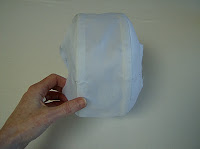A quartet of sleeve shapes to show you today- I think these are the reason I feel swamped and am working overtime.
The challenge was to make Renaissance type period sleeves "cubist" in effect, so in the places where you might see a soft gathered puff of fabric around the elbow for instance, we want to achieve more geometric shapes. These are some of the preliminary thoughts in three dimensions- I didn't take pics of the accompanying patterns- that was thoughtless of me- I'll try to find time to do that. The workings of my brain these days feels rather disconnected.
Okay, I know I mix my measuring systems around- I use metric and imperial freely to suit my purpose - usually depends on whether I am dividing or not.
 The pentagon- similar process- a central panel with the circumference and height chosen, marked off in five equal sides, then shaped in above and below into an offset circle so that the bulk of the shape was on the outside of the arm (negligible effect). The shaping above and below the central panel- is a five sided funnel which I figured out really easily on the day but it totally eludes me today.
The pentagon- similar process- a central panel with the circumference and height chosen, marked off in five equal sides, then shaped in above and below into an offset circle so that the bulk of the shape was on the outside of the arm (negligible effect). The shaping above and below the central panel- is a five sided funnel which I figured out really easily on the day but it totally eludes me today.  The lantern. This started with a piece of 2" grosgrain for the central panel, with basically two funnel shapes attached to it. One side of the funnel is long and the other is shorter because i didn't like it and I cut it off which made the hole bigger- but I needed it to be a certain size, so I put in small tucks by eye to reduce the size, then sewed on the twill to hold it there. Sometimes the things that go wrong initially can lead you to shapes you hadn't thought of originally. I like this shape.
The lantern. This started with a piece of 2" grosgrain for the central panel, with basically two funnel shapes attached to it. One side of the funnel is long and the other is shorter because i didn't like it and I cut it off which made the hole bigger- but I needed it to be a certain size, so I put in small tucks by eye to reduce the size, then sewed on the twill to hold it there. Sometimes the things that go wrong initially can lead you to shapes you hadn't thought of originally. I like this shape. The cheese wheel- this is similar to the lantern except that the central panel is wider and the "funnels" attached to them are flat. They are just circles of the required circumference to attach to the central panel, with off set circular holes of the required dimensions for the size above and below the elbow. Not successful really.
The cheese wheel- this is similar to the lantern except that the central panel is wider and the "funnels" attached to them are flat. They are just circles of the required circumference to attach to the central panel, with off set circular holes of the required dimensions for the size above and below the elbow. Not successful really.
Draw up the base shape that is repeated eight times, cut in some horrible nylon stuff, stitch together and hold the shape out with riglene nylon boning. I think it could be less sloppy looking if it had been sewn a bit differently. The riglene really needs to be machine sewn to hold the shape out. Sewing them can be a bit of a trial and error process. ("oh, but don't forget we have a tight budget") Budgets are another story in themselves, I won't go there.
Stitch in rigilene along the central panel, bending it at the facets. We ended up using this one on the costume and we put a circle of rigilene inside the pentagon of riglene to ensure it will never collapse.
We also needed to keep in mind that the fabric coverings will need to be ever so slightly bigger so they float just on the shape; too tight and it will distort the shape, too loose and it will look sloppy.
These are just the little shapes around the elbow- there are different shapes above and below these which make for a huge amount of pattern making, and cutting- probably 3 to 4 times the usual required for a costume.
No comments:
Post a Comment